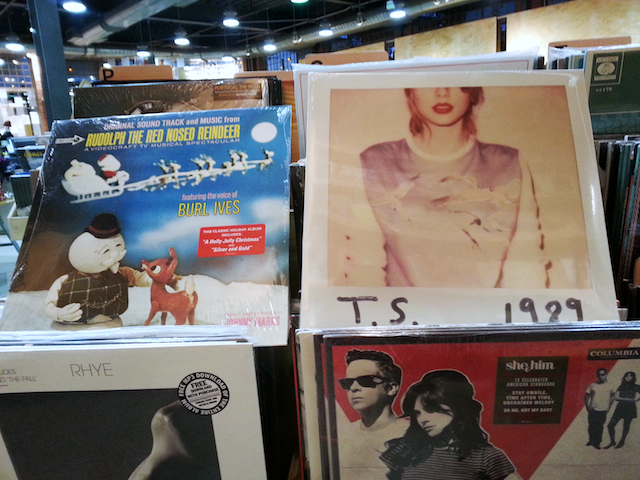“I need more bandwidth!” After hours of being so deeply engrossed in his Minecraft dominion that he had barely acknowledged anyone else in the room, my brilliant nine-year-old nephew stomped his feet on the floor and shouted this demand at his parents, smiling but serious. To him, it was an entirely reasonable request. But I couldn’t help but regard it as a wry commentary on our cultural moment.
From the perspective of a middle-aged critic like myself, the ties that bind us together seem increasingly tenuous. Even when vast amounts of energy course through them, its power is usually throttled by the narrowness of the conduits it must pass through. In a world where most culture is available on demand — for those who can afford it — and frequently with almost no delay, it is possible to indulge the specificity of our taste preferences as never before. But this degree of personalization has a major drawback.
When you can get exactly what you think you want, you are less likely to desire anything truly new. The repetition with a difference in which psychoanalytic thinker Jacques Lacan and his followers discern the sole freedom available to us is seems more and more like repetition without a difference that actually matters. Instead of being led serendipitously astray by our failure to find exactly what we are looking for, we instead retrace our steps on the same small stretch of ground, like animals at the zoo who have forgotten what it feels like to have liberty of movement.
I was painfully reminded of the largely invisible walls of this cultural prison as I shopped for holiday gifts for my family over the past week. Although we owed my nephew, visiting from Idaho, a belated birthday present as well as something for Christmas, it proved impossible to find anything suitable without consulting him first. And even when I gave up and asked him to pick something out at our local Barnes & Noble bookstore, it took him hours to locate anything he cared about enough to ask for.
What he really wanted was “more bandwidth” for the game that consumes the majority of his free time, a way to get more information about his place in the Minecraft universe and to get it faster. But I did not understand how to procure this for him. Not to mention that, even if I had known how, I would have been reluctant to reinforce the isolation with which the game appeared to be afflicting him.
Finally, he ended up picking out a deluxe set of Pokemon cards. Although the gift made him happy enough to inspire the writing of a handwritten thank-you note, it left me even more unsettled. He chose it, you see, because it returned him to an earlier stage in life, when it had been much easier for others to please him. Even though he is only in third grade, in other words, he had to fall back on nostalgia in order to complete this holiday ritual.
What disturbed me in this move was not my nephew’s choice of commodity, but the insight it provided into how the vast majority of consumers behave these days. A high percentage of the items featured in the bookstore’s displayed were examples of what I call “reissue culture”, repackaging goods in such a way that people who had them in the past — and, in many cases, still have them today, in some form — will buy them again. And it was clear, as I watched people queue up to make their purchases, that it was these items, rather than genuinely novel ones, that were most likely to keep the financially troubled Barnes & Noble chain afloat.
It can be assumed, of course, that most of these individuals were buying presents for others rather than themselves. But I couldn’t shake off the impression that it was usually their own favorites which they were procuring, as if they couldn’t imagine giving someone else a gift that didn’t align with their own sense of self. The ambient narcissism was overwhelming. To be fair, though, I wasn’t just a flâneur, contemplating the passions of these customers with cool dispassion. I was fighting hard against the same compulsion to repeat previous acts of compulsion.
Should I buy yet another edition of Lord of the Rings, because it came in a nice slipcase? This fiftieth-anniversary set of figurines based on the Rankin-Bass Rudolph the Red-Nosed Reindeer television special, even though I had purchased a less complete one at this very store over a decade ago? Or how about this attractive “drop-case” hardcover copy of Lydia Davis’s translation of Swann’s Way?
My nephew’s difficulty, I realized, wasn’t some generational defect, but a condition that all consumers increasingly share. This became even more obvious yesterday, when I was scrambling to flesh out the offerings to be placed under our Christmas tree. Although we already have almost every Beatles recording, I seriously contemplated getting my John and Paul-obsessed sixteen-year-old daughter a box set just because it would be nice to have everything in one package. And, while I managed to avoid that irrational temptation — after all, she does most of her listening on YouTube — I gave in to others.
For her mother, I bought the portable phonograph that she had been lusting after because it reminded her of one she had as a child. But that meant buying something for her to play on it, which led me to get her the vinyl reissues of Pink Floyd’s The Wall and Van Morrison’s Moondance, two of her favorite albums, even though I know full well that her old LPs were sitting at home on the shelf and also has accesss to both albums on CD.
Even more illustrative of my point was my decision to get the newly remastered version of my favorite Sleater-Kinney album, The Hot Rock. Because I have tickets to see two stops on the band’s reunion tour and have visions of getting my daughter the aspiring musician to accompany me, I decided that giving her the record as a gift would be an ideal way to introduce her to the band’s work. At first I considered buying the vinyl, since she had received the portable phonograph she had asked for on her birthday in October. But then I thought that the CD would make more sense, since we often listen to music together in the car.
That’s when it hit me, though. Not only do I have the original CD of the album, which already sounds great, but it is also loaded onto the iPod Classic I can play through the car stereo, available on Spotify, which we subscribe to, and also not hard to find on YouTube, which is how she prefers to listen to music anyway. In other words, there was really no reason for me to buy The Hot Rock again, unless out of a desire to reward Sleater-Kinney again for making such fine music. Yet I went ahead to purchase the CD and had it wrapped up as a Christmas present.
My point here is not to overemphasize the perversity of decisions like this one. Nor is it to imply that they represent an entirely new phenomenon. Rather, I mean for these personal examples to stand for the broader trend towards reinforcing a sense of selfhood through repetitive consumption. I do think that it’s increasingly common for people to devote what spending money they have on cultural goods that they know will please them because they were already pleased by them in the past. And while doing that might reinforce the connection they perceive with those favored goods, it is necessarily going to restrict the amount of money and time they have to become acquainted with anything that represents a departure, however slight, from the tried and true.
This conservatism manifests itself in another way these days. Although sales for individual books, movies and particularly records have been in decline since digital distribution became feasible, the sum total of consumption — though frequently not paid for — is only increasing. People have never spent more time engaged in cultural pursuits, even though their impact frequently seems mild compared to what transpired in the 1960s or 1920s. Yet because it is easy for them to concentrate on their own narrow taste preferences, the potential for common experiences has decreased.
That’s why, I would argue, we see so much energy being devoted to news stories about culture that allow us to communicate on the basis of shared knowledge. The story about North Korea possibly hacking Sony to prevent the release of The Interview is only the latest example. It’s also why those few cultural goods that do become cross-over hits can so dominate the marketplace. Last year it was the Disney animated film Frozen, which became a touchstone for people, like the American Marines shown singing along to “Let It Go”, who would seem to have little interest in what was, in theory, a film targeted specifically at pre-adolescent girls. This year, increasingly, it’s the Taylor Swift album 1989, which has outsold all the other albums on the Billboard chart beneath it to a degree that is almost inconceivable.
On my nephew’s last night in Tucson, we were driving home from a trip to the local twenty-four-hour diner when my daughter asked if she could play some music. The cousins rapidly agreed to hear “Shake It Off” and “Blank Space” on my sister’s iPod. Given how focused my nephew is on his Minecraft activities, the fact that he knew this music at all was a surprise to me. But what really struck me was the fact that, like my daughter, he knew every word, even though neither of them could really be classified as Taylor Swift fans. As they sang happily along together, finding a few moments of commonality amid what had been a visit defined by divergences, I realized that what mattered most to them wasn’t the music itself, but the mere fact that its ubiquity had turned it into something they could share without too much effort.
At a time when we feel increasingly fragmented by the sheer availability of cultural offerings, such opportunities to be on the same page seem especially important. And, while most of them might derive from reissue culture, the fact that a few new releases, like 1989 achieve massive success suggests that the desire to share transcends mere nostalgia. Our challenge is to find a way to make it matter in less superficial ways. Singing along is better than singing alone. But acting in concert is better still.
Photograph courtesy of the author.





